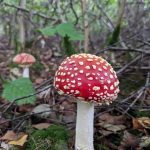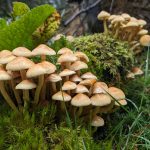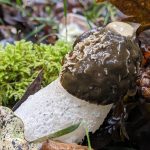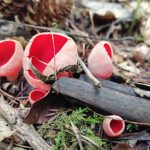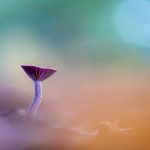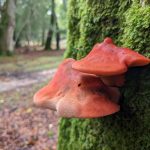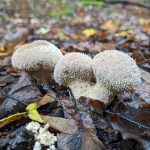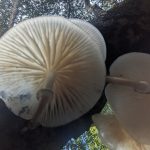Eight fungi to find in woodland this autumn!
November 13, 2023
The days during autumn, leading into winter are a magical time to explore woodland searching out fungi. Crisp, golden leaves carpet the ground and shafts of sunlight stream through bare branches illuminating the different colours and textures of a treasure trove of toadstools. Go slowly, allow your senses to sharpen to pick out these tiny wonders.
With more woodland by area than any of the other English National Parks, the South Downs National Park is the perfect place to try a woodland fungi foray. Whether it be in a small stand of trees such as the distinctive beech crown at the top of Chanctonbury Hill, ancient woodland at Kingley Vale, or a large mixed forest like Queen Elizabeth Country Park there’s an option for everyone.
There are nearly 15,000 fungi in the UK, a great many of them to be found in woodland and the damp conditions of late summer to early winter are the ideal time for spotting them. Fungi play an important role within the woodland, helping to recycle nutrients from dead or decaying organic matter, and providing food and shelter for different animals.
Here’s a few fantastic fungi to look out for on your South Downs woodland wander (Be aware that fungi can be deadly poisonous – please just look and enjoy their presence!):
Fly agaric
Probably our most familiar toadstool, and the one most people look out for, is the fly agaric (Amanita muscaria). Its bright scarlet or orange cap covered with white spots is the quintessential fungi – even having its own emoji!
Usually found in mixed woodland, preferring birch, pine or spruce to be nearby.
Sulphur tuft
A common fungi to spot in mixed or coniferous woodland, is the sulphur tuft (Hypholoma fasciculare), which grows in conspicuous clusters on exposed roots, fallen trees or dead wood, creating stunning yellow fairy-castle like eruptions.
Stinkhorn
The stinkhorn (Phallus impudicus) may be located by its foul rotten flesh odour.
Flies find them irresistible and provide the fungi with a means of transporting its spores throughout the forest.
Often only lasting a few hours in its full phallic slimy green form, immature stinkhorn or ‘eggs’ can be seen glistening white in the leaf litter or moss before erupting.
Scarlet elf cup
Also known as fairies’ baths, the scarlet elf cup (Sarcoscypha coccinea) is a saucer shaped red fungus often found poking out from the leaf litter or sprouting from decaying wood.
Imagine those fairies having a tea party with their elf cups!
Amethyst deceiver
If you go slowly and have a very sharp eye you may spot the delicate, beautifully named, and easy to miss amethyst deceiver (Laccaria amethystina) a tiny purple drop bonnet type fungi in the leaf litter.
Beefsteak fungus
The beefsteak fungus (Fistulina hepatica) is so called as it looks disconcertingly like raw meat and gives off a grim looking bloody goo when rubbed.
A quite common variety of bracket fungus in woodland and often seen poking out of an oak tree trunk.
Porcelain fungus
Often found taking over fallen beech limbs and even sometimes on living beech trees, the common (Oudemansiella mucida) is a glistening translucent white beauty.
If possible, get underneath and look up through the gills to get the full effect.
Common puffball
Also known as the devil’s snuff box, the common puffball (Lycoperdon perlatum) is a white upturned pear shaped fungi with white wart-like specks on the surface.
Spores escape from a hole in the top when mature, often bursting out when touched.

